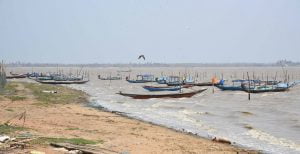Bhubaneswar/Satapada: It’s unusual, but not alarming, said chief executive of Chilika Development Authority (CDA) Susanta Nanda about the four new mouths that Cyclone Fani left behind along with a trail of devastation in Asia’s largest brackish water lagoon.
Prior to May 3, Chilika had two functional mouths – one near Sanpatna and the other near Arakhakuda village – connecting the Bay of Bengal. Wave energy coupled with high tidal prism during Fani led to the creation of three more mouths along the same stretch and a fourth beyond Arakhakuda.
“The immediate impact will be good as the lake will witness a rise in migration of fish and catch. The increase in salinity level will also help kill water hyacinths, the most noxious aquatic weeds,” Nanda said.
Water hyacinths form a dense layer across the surface of a water body, restricting sunlight penetration, which underwater fauna need for sustenance. The plants then decay and die out, bringing down the dissolved oxygen levels. This adversely impacts the fish and other aquatic beings, which then perish.

“Our scientists are collecting samples and monitoring the parameters. Since monsoon is just a month away, we expect it to moderate the salinity along with the 52 rivers that drain into the lake,” he said.
Nanda further said that these mouths may eventually close in two to three months, because of lateral sediment transportation (south to north).
Former CDA chief executive Ajit Patnaik echoed his views. “Whether there is one mouth, two mouths or 10 mouths, it hardly matters. The most important thing is salinity gradient of the lake. If the desired salinity, which on an average is 15 ppt, and tidal influx of 40 per cent is maintained, then the lake is fine,” he said.
Explaining further, he said tidal influx is the difference in water level between high tide and low tide.
“When salinity increases, fish production improves,” he said.
Patnaik had played an important role in restoring the lake in 1999 after it was added to the List of Ramsar sites in danger (the Montreux Record) in 1993. The CDA had then desilted the channel connecting the lagoon to the sea and opened a new mouth in 2001 to restore the natural flow of water and salinity level. Within a couple of years, there was an increase in the lagoon’s fish yield and a reduction of freshwater weeds.
“The fish production had then spiraled to 10,000 MT and subsequently maintained at 12,000 MT,” he said.
Allaying any fear regarding the extra mouths, he said CDA has the equipment to measure salinity at the pre-determined geo locations. “If an alarming situation arises, they can consult experts,” he said, adding that except for the one active mouth, the others will close in a month or two due to sediment transportation.

However, Nalabana Bird Sanctuary was affected because of increase in salinity gradient post opening of the new mouth over a decade ago. This had triggered a controversy at that time.
“The sighting of greater flamingo on the island after cyclone Fani is a good sign,” said Dr S. Balachandran, deputy director of Bombay Natural History Society (BNHS), which takes part in the annual census of migratory birds in Chilika.
He said that Fani was less severe than Cyclone Gaja, which had wiped out thousands of birds with 90 per cent of them subsequently deserting bird sanctuaries in Tamil Nadu in 2018.
According to Balachandran, Fani coincided with the natural phenomenon of seawater ingress, which takes place in the first or second week of May, because of which the subsequent impact is likely to be nominal. “The cyclone advanced it a bit. Migratory birds too leave the islands in Chilika by May 15, as these submerge due to seawater intrusion and it continues through the monsoon. The water recedes only in October and November when the avian guests fly down for their winter sojourn,” he said.
Balachandran said that there were no immediate reports of bird casualty.

The fishermen community in Satapada are still in a state of shock. The storm surge of over 10 feet completely damaged their boats and nets. Deba Jena pointed at the sandy heaps over the green cover after the severe cyclonic storm ravaged the place. Further down, four more mouths have opened. “These will increase the salinity of water and improve fish production. But the fishermen have lost boats and net, how would they go for the catch?” he asked.
“We have seen additional mouths opening in the past. These will close subsequently,” he said.
However, this is not the first time that such mouths have opened in the brackish water lagoon. It had happened during cyclones Phailin and Hud Hud, in 2013 and 2014, too. The lake had three mouths way back in 1971 when a Super Cyclone struck the state. But no new mouth was created during the 1999 Super Cyclone.


